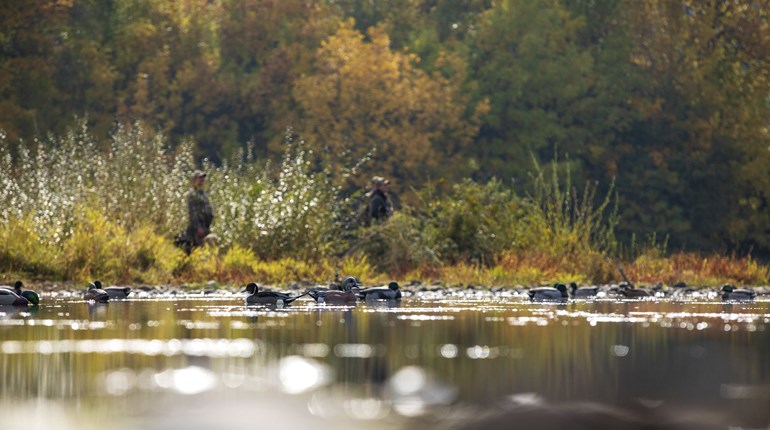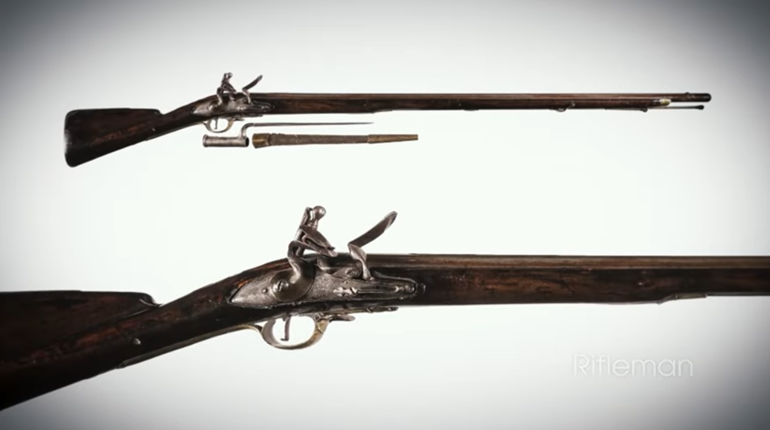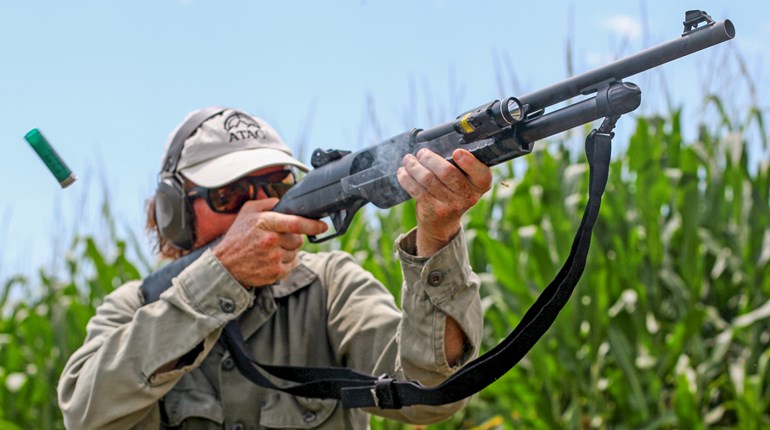
I first saw the boat in 1981, covered with dust and sitting in an old barn in Ohio. The owner—a fellow waterfowler—claimed that it was an original Dan Kidney Sneak Boat, built by the legendary boatbuilder in 1919 at his shop in DePere, Wisconsin. At the time, I knew nothing about Dan Kidney or sneak boat hunting, but was more than willing to learn, as I’d always been interested in waterfowling history. So I didn’t quibble about the price, just paid the man what he asked and trailered the boat home.
At 20’ long with a 54” beam, my Kidney Sneak Boat was the largest-sized sneak Kidney made. Built of cedar strips approximately 1" wide by half-an-inch thick by several feet long, the boat was extremely heavy for its size. The weight kept its profile low in the water, a must for sneak boat hunting. In essence, it looked like an overgrown canoe.
“That thing’s gonna drown us both,” Dave, my hunting buddy, quipped upon first seeing the boat.
Nevertheless, we made minor repairs to the hull and gave the entire boat a fresh coat of battleship-gray paint, the color of leaden lake waters in November. We then christened the sneak boat “Grandfather,” as it was older than the two of us combined.
But before we could even think of hunting the boat it had to be made watertight. The previous owner had instructed me to leave the boat on the trailer and fill the cockpit with water from a garden hose. For a week or more the sneak leaked copiously, but the cedar gradually swelled and tightened. We were finally ready to hunt.
Dan Kidney’s career as a commercial boatbuilder spanned some 51 years. During that time, he and his employees built thousands of boats, but the one that spread his name nearly worldwide was the famous Green Bay Hunting Boat. It was of a long, narrow, two-ended design, built with a shallow draft and a large load capacity. The huge cockpit in relation to the total size of the boat made it easy to carry the many decoys, shotguns, shells and other necessities for a day’s waterfowling.
The difference between the Kidney Sneak Boat and the Green Bay Hunting Boat was mainly in construction. The Sneak Boat had a strip-build, smooth-sided design as compared to the lapstrake design of the Green Bay. A smooth-sided hull made the sneak quieter and faster in the water.
My buddy and I hunted with Grandfather for years, mainly offshore along the famous Lake Erie marshes that ringed the lake’s Western Basin, as well as on adjoining Sandusky Bay. At first, we made all the rookie mistakes, as we had no idea what we were doing. But gradually the mistakes became fewer, and our daily bag of ducks grew larger.
A day of sneak boat hunting began many hours before dawn. As with most waterfowling, it was preferable to be on the shooting grounds with decoys set and the boat in position before the first flocks of ducks began moving at daybreak. This was important because many times the first hour or two of daylight offered the best shooting of the day.
My Kidney Sneak Boat had a motor mount attached, which was not original equipment. A small, six-horsepower outboard pushed the boat, but before outboards were reliable, hunters rowed their sneak boats to where they wanted to hunt. Each new Kidney Sneak Boat came complete with two sets of oar locks and four oars.
Upon arrival at the area we had chosen to hunt on any particular day, my hunting buddy and I would begin the chore of setting out decoys. The traditional number of decoys used in sneak boat hunting was 72, but at times we had well over 100 “blocks” on the water. We eventually learned, however, what the old-timers already knew: That six dozen decoys was about right.
After the decoys had been placed and the spread fine-tuned through argument and compromise, we motored upwind and anchored. The next step was to secure the blind to the front of the boat. The blind or screen was a thin piece of plywood about 6' wide by 2' high that attached to the front deck. It extended about a foot past both sides of the boat and had canvas skirts that hung from the bottom of the blind, almost touching the water. The purpose of the blind was to hide the hunters and any of our movements from ducks as an approach to the decoys was being made. A narrow opening, cut horizontally into the blind, allowed us to watch the ducks’ movement and behavior as the boat approached the decoys.
Once all the many preparations were complete, it was finally time to uncase the shotguns, load and await the ducks. And depending upon the weather, this waiting could either be pure pleasure or an endurance test. During early season, when the weather was normally mild and skies blue, the waiting involved eating sandwiches and swapping stories of hunting seasons past. Later in the year, however, when temperatures plummeted, the waiting was spent huddled on the floor of the boat, sipping hot coffee and trying not to freeze to death. But the reward for this cold-weather hunting was that the time between flights of ducks was usually shorter.
At the first light of dawn, ducks would begin to move, and when hunting the Great Lakes, that meant skeins and skeins of waterfowl trading back and forth, high in the sky. A duck hunter’s pulse quickens at these sights and anticipation grows. On a good day it was not long before a flock of ducks noticed our decoys rafted well offshore and circled for a closer look. Seeing the mixed flock of mallards, pintails, scaup, canvasbacks, redheads and buffleheads bobbing on the water, the real ducks often joined the decoys and the sneak began.
Sitting in the stern of the boat, I reach back and unhook the anchor rope. The sneak boat is now free, and the gentle breeze pushing against the blind slowly begins moving the boat downwind, toward the ducks. On my knees, I slip a paddle with a 10-foot handle over the side of the boat to act as a rudder. My partner, kneeling in the front of the boat behind the blind, acts as navigator, telling me through hand signals which way the ducks are moving in the decoys.
When a sneak begins, the distance from boat to decoys can be anywhere from a few hundred yards to more than a quarter-mile, depending on weather, visibility and how the ducks are reacting on any particular day. An ideal sneak-shooting wind is one that moves the boat toward the ducks at a steady, even pace. If the boat approaches too fast, the birds will flush before we can get within shotgun range. The idea is to drift toward the ducks in such a slow, imperceptible way that they don’t recognize the object moving toward them as potential danger until it’s too late.
Halfway to the decoys, now, the sneak boat begins picking up speed. My buddy signals that there are five ducks in the spread—lesser scaup, I think, hunters call them bluebills—and they’re moving to the right side of our decoy spread. I pull on the paddle/rudder and the boat moves right, into a better line.
The last 100 yards of a sneak are the most critical. Any noise or movement by the hunters may cause the ducks to spook and flush prematurely. At 80 yards, the ducks begin to get nervous. They bunch into a tight flock and begin swimming rapidly toward the back of the decoy spread, away from the approaching boat. At 60 yards, the ducks’ instinct is to fly, but the decoys, showing no signs of concern, cause them to procrastinate. At 40 yards, the birds have waited too long and are now within range.
The sneak boat has done its job well and continues to close the gap by the second. At 30 yards, the ducks have finally had enough and flush from the water in full-blown panic. At the same instant, my hunting buddy releases the blind which falls forward onto the front deck of the boat by way of a set of hinges. Simultaneously, two 12-gauge shotguns begin barking, and together we bag three of the five ducks. It’s maybe not the greatest exhibition of shooting, but about average for us. Picking up the downed ducks, we find we’ve taken two drakes and a hen.
Early in the 20th century, sneak boats and sneak boat hunting were common. Today, most open-water waterfowling is done from layout boats. Along with this change in hunting technique also came changes in boat-building materials, namely fiberglass. As a result, the demand for handmade, wooden duck boats ran to a trickle. Sadly, in the mid-1960s, the Kidney Boat Works closed its doors forever.
The rare Dan Kidney duck hunting boats remaining today are highly sought-after by collectors, nostalgia buffs and a few romantic waterfowlers who still hunt them. Owning and hunting an original Kidney Sneak Boat was one of the highlights of my waterfowling career. I sold the boat many years ago to a wide-eyed young hunter who was just as excited to become its proud owner as I had once been. I sometimes wonder where that boat is today. Hopefully, it’s not tied up into the ceiling of some boathouse, forgotten. Rather, I like to believe that Grandfather is still plying the offshore waters and bays somewhere in the Great Lakes region each autumn, thrilling the current generation of sneak boat waterfowlers.






































